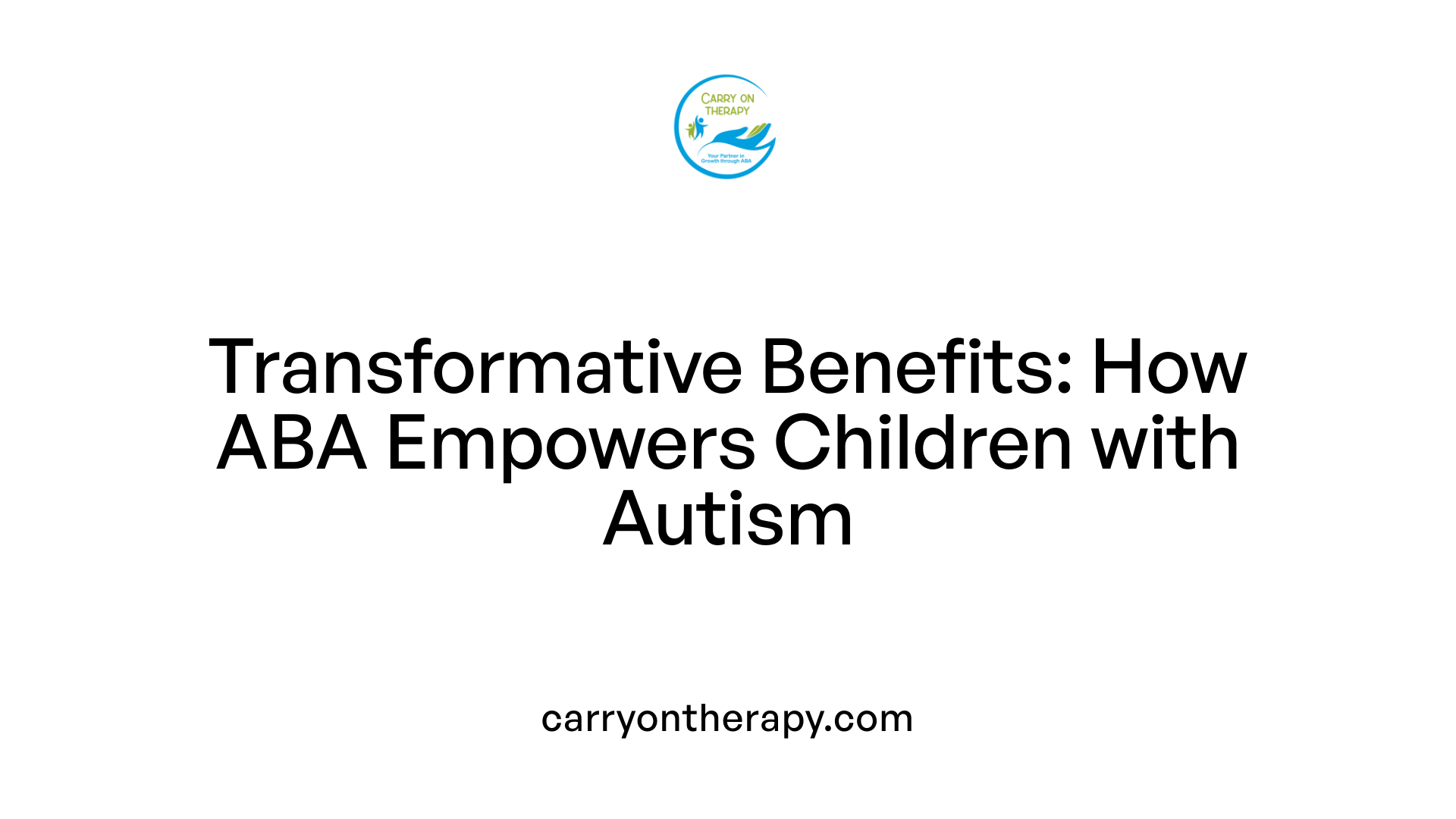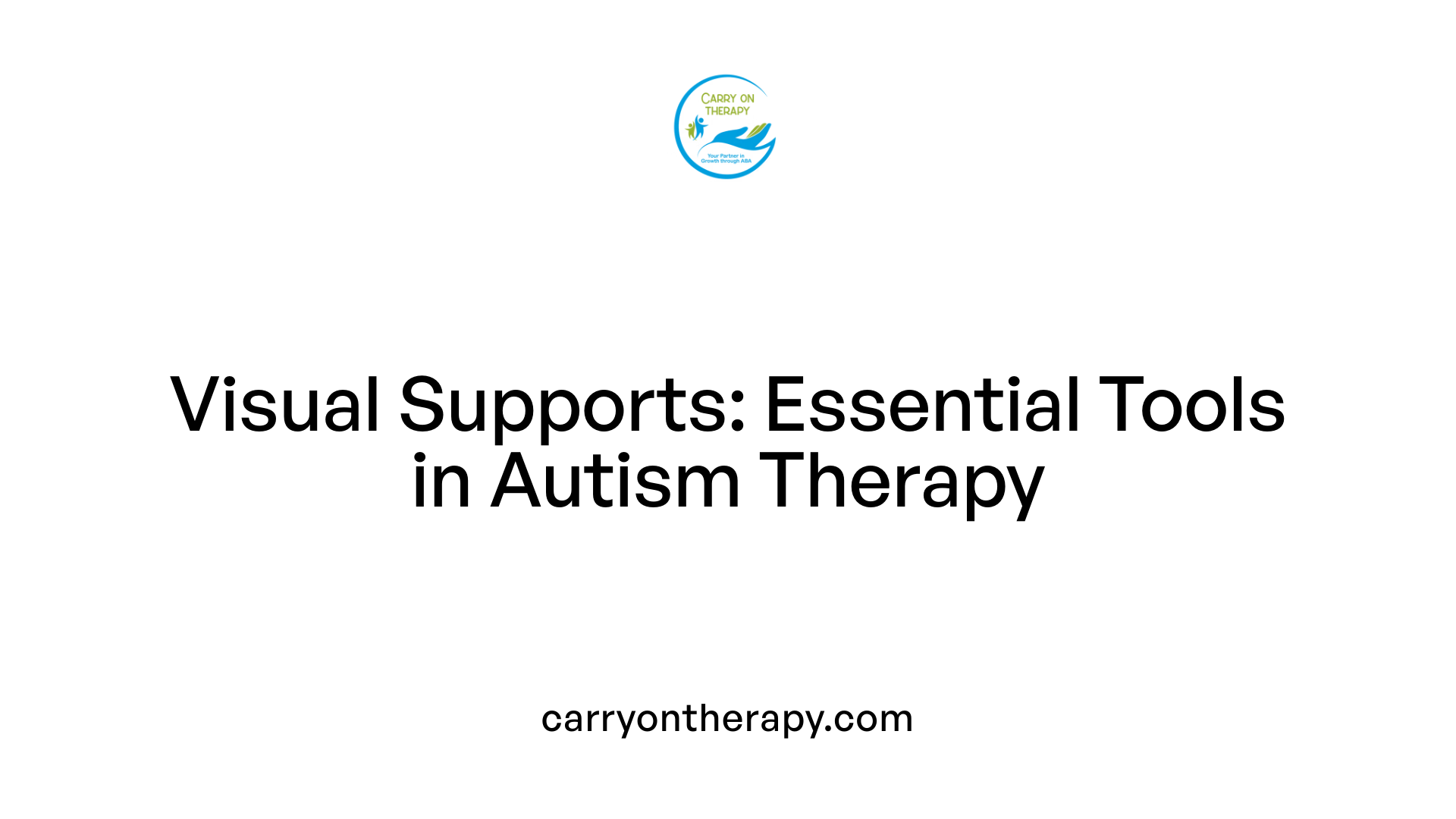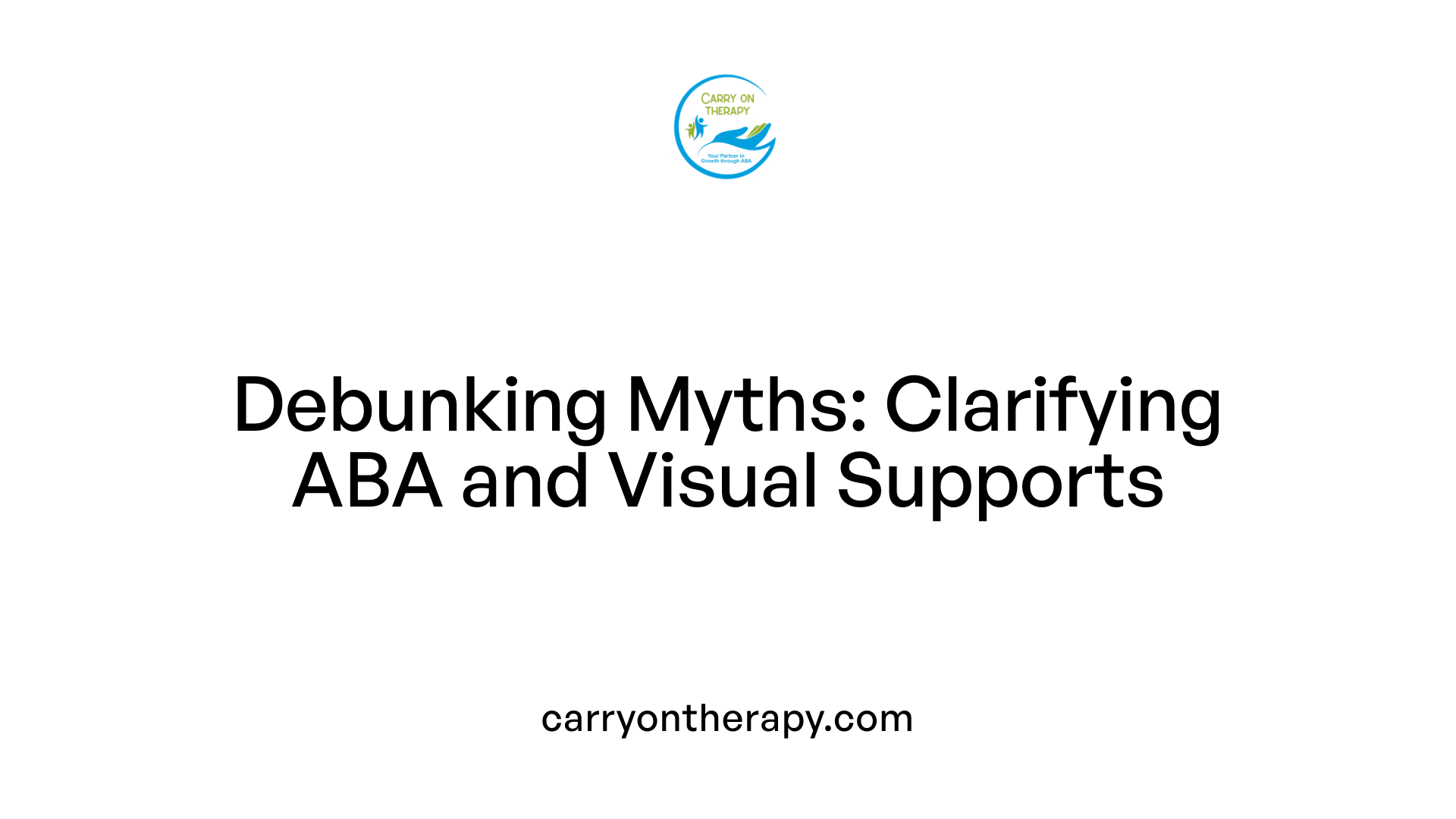The Role of Visual Supports in Therapy for Children with Autism
Enhancing Autism Therapy Outcomes Through Visual Supports

Understanding the Impact of Visual Supports in Autism Therapy
Visual supports are powerful non-verbal tools designed to aid children with autism in communication, understanding daily routines, and managing emotions. This article explores their critical role within therapeutic approaches, particularly applied behavior analysis (ABA), and how they contribute to improving developmental outcomes for children with autism spectrum disorder (ASD).
What is Applied Behavior Analysis (ABA) Therapy and Its Use in Autism Support?

What is applied behavior analysis (ABA) therapy and how is it used to support individuals with autism?
Applied Behavior Analysis (ABA) therapy is a scientifically grounded approach that applies learning theory principles, especially operant conditioning, to help individuals with autism spectrum disorder (ASD). It focuses on understanding and changing behavior by carefully analyzing the situations that precede and follow actions, aiming to increase helpful behaviors such as communication and social skills while reducing harmful or challenging behaviors.
Role of ABA in autism intervention
ABA is widely recognized as an evidence-based treatment for ASD. It targets multiple developmental domains including cognition, language, social skills, and problem behaviors. Interventions are personalized to each child's unique needs — informed by ongoing data collection which guides adjustments in therapy to maximize progress.
Methods used in ABA such as discrete trial training and pivotal response training
Among the various techniques employed in ABA are Discrete Trial Training (DTT), which uses structured, step-by-step teaching sequences with reinforcement, and Pivotal Response Training (PRT), a naturalistic method focusing on developing critical skills like initiating communication during everyday interactions.
Involvement of professionals like Board Certified Behavior Analysts (BCBAs)
ABA programs are developed and supervised by Board Certified Behavior Analysts (BCBAs), who conduct thorough assessments and design individualized treatment plans. This professional oversight ensures that interventions are systematic, goal-oriented, and scientifically informed.
Tailored treatment plans and data-driven progress monitoring
Treatment plans in ABA are customized and continuously refined based on collected data to monitor a child's improvements. Progress is regularly measured across key skills to ensure the therapy remains effective and responsive to the child's evolving needs.
Early intensive ABA therapy benefits
Early Intensive Behavioral Intervention (EIBI), an intensive form of ABA initiated before age 4, has shown significant developmental benefits. Children receiving early ABA often exhibit measurable gains in language, social functioning, and overall adaptive behavior, contributing to better long-term outcomes.
ABA therapy is thus a comprehensive, adaptable, and research-supported approach that plays a pivotal role in helping children with autism develop essential skills and improve quality of life.
Key Benefits of ABA Therapy for Children with Autism

What improvements does ABA therapy bring in communication, social interaction, and daily living skills?
ABA therapy significantly improves communication and social skills by using structured methods like Discrete Trial Training (DTT), Pivotal Response Training (PRT), and Functional Communication Training (FCT). These approaches enhance children's ability to express needs, engage with others, and develop adaptive behaviors crucial for daily living. Visual supports further aid understanding and communication, aligning well with the natural learning preferences of children with autism.
How does ABA help reduce problematic behaviors?
By applying principles of operant conditioning, ABA therapy encourages desirable behaviors while discouraging undesired ones through consistent reinforcement and systematic behavior tracking. This reduces challenging behaviors such as tantrums and aggression, leading to a more positive and manageable environment for both children and caregivers.
In what ways is ABA an individualized and evidence-based treatment?
ABA plans are personalized by Board Certified Behavior Analysts (BCBAs) based on each child's developmental profile and goals. Techniques like task analysis, prompting, and data-driven decision-making ensure the therapy adapts continuously to the child's progress. Research supports ABA's effectiveness, with 63%–88% of studies reporting improvements in language, social skills, and adaptive functioning across diverse models such as Early Intensive Behavioral Intervention (EIBI) and the Early Start Denver Model (ESDM).
Why is early intervention important in ABA therapy?
Starting ABA interventions in early childhood maximizes developmental gains, particularly in foundational communication, cognition, and social skills. High-frequency, targeted early programs improve long-term outcomes, helping children achieve greater independence and reducing the need for more intensive support later.
How does ABA prepare children for mainstream education and social integration?
ABA therapy supports educational goals by enhancing executive functioning, social interaction, and behavior management compatible with individualized education plans (IEPs). Parent training and family involvement promote consistent skill development in various settings, facilitating smoother inclusion in mainstream classrooms and social communities.
| Benefit Area | ABA Contribution | Description |
|---|---|---|
| Communication & Social Skills | Structured teaching & communication aids | Increases ability to express needs and engage socially |
| Reduction of Problem Behaviors | Reinforcement & behavior tracking | Decreases tantrums, aggression, and other challenging behaviors |
| Individualized Approach | BCBA-supervised, data-driven plans | Tailors therapy to individual strengths and needs |
| Early Developmental Gains | Intensive early intervention | Enhances foundational skills leading to better long-term outcomes |
| Education & Social Integration | Support for IEPs & family involvement | Prepares children for school inclusion and community participation |
Credentials and Roles of ABA Therapy Providers

Who provides ABA therapy and what qualifications do they need?
ABA therapy is delivered by a range of professionals, each with specific qualifications and roles ensuring effective treatment for individuals with autism spectrum disorder (ASD).
Board Certified Behavior Analysts (BCBAs) lead ABA therapy programs. These are graduate-level clinicians who hold a master's degree in fields like psychology or special education. They must complete supervised practical experience and pass a rigorous certification exam administered by the Behavior Analyst Certification Board (BACB). BCBAs design, oversee, and adjust individualized treatment plans to enhance developmental domains such as communication, social skills, and behavior management.
Registered Behavior Technicians (RBTs) are paraprofessionals who implement ABA interventions directly with clients under BCBA supervision. To qualify as an RBT, candidates need at least a high school diploma, complete specialized training, and pass a competency assessment. RBTs play a vital role in carrying out therapy sessions, collecting data, and applying behavior-analytic strategies as prescribed.
Behavior therapists and assistants vary in their educational backgrounds. Some may have additional certifications or degrees related to therapy or special education, while others receive training focused specifically on ABA methodologies. They support the BCBA and RBT by delivering treatment, monitoring progress, and ensuring consistent implementation.
Certification and licensing standards are critical across all roles to maintain quality and ethical ABA service delivery. These standards ensure that therapists have the knowledge and skills to provide evidence-based interventions safely and effectively.
Professional expertise influences therapy outcomes significantly. Competent providers use data-driven decision making, adapt interventions to individual needs, and collaborate with families to promote generalization and lasting improvements. Thus, choosing qualified providers is essential for maximizing the benefits of ABA therapy.
Structuring ABA Therapy Programs for Children with Autism

How is an ABA therapy program structured for an individual with autism?
An ABA therapy program for a child with autism begins with a comprehensive assessment conducted by a Board Certified Behavior Analyst (BCBA). This assessment identifies the child’s strengths, challenges, and developmental needs across several domains such as communication, social interactions, cognition, and behavior.
Following this, an individualized treatment plan is developed. This plan sets specific goals tailored to the child’s unique needs, aiming to improve communication skills, social behaviors, and to decrease problem behaviors. Evidence-based intervention strategies form the foundation of this plan, including pivotal response training (PRT) and the Early Start Denver Model (ESDM). These strategies emphasize naturalistic teaching and motivation.
Discrete Trial Training (DTT) is often incorporated as a structured, step-by-step teaching method to build foundational skills, while naturalistic teaching encourages learning in real-life environments. Therapy is delivered across varied settings — at home, in clinics, or school environments — to promote generalization of skills.
Parental involvement plays a vital role in the program’s success. Parents receive training and coaching to consistently reinforce learned skills at home and in daily routines. This consistent reinforcement helps ensure the child’s progress is maintained across contexts.
Ongoing progress monitoring is conducted through systematic data collection. Regular evaluations allow BCBAs and therapists to make adjustments to the program as the child’s abilities and needs evolve, ensuring the therapy remains effective and relevant.
This comprehensive and flexible structure supports meaningful improvements in communication, socialization, and behavioral adaptability for children with autism.
The Vital Role of Visual Supports in Autism Therapy

What Are Visual Supports and Their Types?
Visual supports are non-verbal communication tools designed to help children with autism better understand and express their needs. Common types include visual calendars, schedules, picture cards, feelings and emotions charts, and communication aids such as sign language or electronic devices with speech outputs.
Why Do Children with Autism Prefer Visual Learning?
Many children with autism have a natural preference for visual learning. This innate tendency makes visual supports particularly effective, as these tools align well with how these children process information.
How Do Visual Calendars and Schedules Aid Routines and Transitions?
Visual calendars and schedules provide a clear representation of daily routines and upcoming transitions. By illustrating what will happen next, they help children anticipate changes, which reduces uncertainty and potential behavioral disruptions.
How Does Predictability Through Visual Supports Reduce Anxiety?
Predictable routines foster a sense of security. Visual aids, by outlining sequences of activities, reduce anxiety by minimizing the unknown elements in a child's day, making transitions smoother and less stressful.
In What Ways Do Visual Supports Promote Communication and Autonomy?
Visual supports empower children to express their needs, desires, and feelings more effectively. Tools like picture exchange communication systems (PECS) enable nonverbal children to communicate, while feelings charts help identify emotions critical for regulation.
Why Are Customized and Durable Materials Important for Visual Tools?
Tailoring visual aids to match the child's developmental level ensures relevance and comprehension. Using durable materials ensures longevity of the aids, which can be personalized by parents and caregivers. Resources like Do2Learn offer ready-made picture cards to assist in this process.
Integration of Visual Supports Within ABA and Other Therapies

Use of Visual Supports Within ABA Techniques
Visual supports play an essential role in ABA therapy, enhancing methods like Discrete Trial Training (DTT) and Natural Environment Teaching (NET). They help structure learning by providing clear, nonverbal cues that children with autism can easily process. For example, visual schedules and cue cards help guide through tasks during DTT, improving attention and reducing anxiety.
Picture Exchange Communication System (PECS) and Its Phased Training
PECS is a specialized ABA-based communication program designed primarily for early or nonverbal children. It uses pictures as a means to communicate needs and desires. Training progresses through multiple phases, beginning with simple exchanges of pictures for items and moving toward more complex communication forms, such as commenting and answering questions.
Visual Emotion and Feelings Charts for Emotional Regulation
To aid emotional understanding, visual representations of feelings and emotions are employed. These charts help children identify and express their emotions more effectively, which supports emotional regulation and reduces behavioral challenges.
Electronic Devices with Speech Outputs Customized to Developmental Levels
Advanced communication aids include electronic devices with speech outputs. These tools are tailored to individual developmental needs and can evolve as the child progresses. Such technology complements traditional picture cards and sign language, enhancing autonomy and communication.
Collaboration of Caregivers in Creating and Using Visual Supports
Parents and caregivers are encouraged to participate actively by customizing or creating visual aids suited to their child’s developmental stage. Using durable materials and relevant images ensures long-term utility. Resources like Do2Learn offer ready-made visual supports that families can adapt.
Visual Supports in Educational Approaches Such as TEACCH
In educational settings, programs like TEACCH incorporate visual aids extensively. Structured routines and classroom adaptations using visual schedules and timetables improve predictability and facilitate independent functioning, aligning well with the advantages observed in ABA interventions.
Common Misconceptions About ABA Therapy and Visual Supports

What are some common misconceptions about ABA therapy for autism?
A prevalent misunderstanding is that ABA therapy is a rigid, one-size-fits-all treatment. In truth, ABA is highly individualized, focusing on each child's unique developmental needs and strengths with customized goals and strategies. It uses positive reinforcement techniques rather than relying primarily on punishment.
Another myth suggests that ABA aims to "cure" autism. Instead, ABA supports improvements in communication, social skills, and daily living, working alongside the child's neurodiversity and emphasizing respect and acceptance rather than eradication.
Some also believe ABA seeks to suppress behaviors solely to enforce compliance. Contemporary ABA prioritizes teaching functional and socially meaningful skills, encouraging autonomy and communication, often integrating visual supports to empower children.
Visual supports, such as picture schedules and communication aids, are mistakenly seen as limiting. Actually, they enhance understanding, reduce anxiety, and strengthen a child's ability to express their needs, promoting independence.
Finally, while quality of life (QoL) remains underexplored in research, ABA's comprehensive, family-involved approach strives to improve overall well-being and enrich life experiences for children with autism.
Future Directions and the Importance of Visual Supports Research

Growing Interest in Large-Scale ABA Studies
Recent years have seen an increase in large-scale studies and randomized controlled trials (RCTs) focused on applied behavior analysis (ABA) therapy. These efforts aim to strengthen the evidence base that supports ABA's effectiveness in improving outcomes for children with autism spectrum disorder (ASD). Despite this progress, many studies still face methodological limitations such as small sample sizes and lack of long-term follow-up.
Need for Robust Data and Addressing Limitations
Acknowledging these limitations is critical for advancing ABA research. More rigorous methodologies and larger participant groups will allow clearer insights into treatment effectiveness, fostering confidence in ABA strategies. This need extends to investigations involving visual supports, where empirical data remains sparse.
Quality of Life (QoL) Research Gap
One notable gap in ASD research is the lack of focus on quality of life (QoL) outcomes, especially concerning visual support interventions. Visual supports—like visual schedules, communication aids, and emotion charts—play a vital role in helping children understand routines, communicate needs, and regulate emotions. Future research must explore how these tools influence broader QoL measures such as emotional well-being, independence, and social inclusion.
Potential Advancements with Visual Supports
Emerging studies suggest that integrating visual supports more deeply within ABA and other therapies could amplify their effectiveness. Innovations may include personalized, evolving communication aids and technology-enhanced visual tools tailored to individual developmental levels. Such advancements promise to better address core challenges faced by children with ASD.
Family and Caregiver Education
Continued education and training for families and caregivers remain essential. Empowering parents with knowledge and resources ensures consistent use of visual supports and ABA techniques beyond clinical settings. This collaboration helps maintain progress and generalization of skills in natural environments.
Enhancing Therapy Outcomes Through Visual Supports
Looking ahead, research focused on visual supports is poised to unlock new pathways for improving autism therapies. With a combined focus on rigorous study designs, QoL considerations, innovative technologies, and family involvement, future initiatives can elevate the role of visual supports in enriching the lives of children with ASD.
The Lasting Impact of Visual Supports in Autism Therapy
Visual supports serve as essential tools in the treatment of children with autism, complementing evidence-based interventions like applied behavior analysis. Their ability to enhance communication, structure daily routines, and aid emotional regulation aligns closely with ABA’s goals of improving functional skills and independence. As research evolves, the integration of visual supports into individualized therapy programs will continue to empower children and their families, ensuring better developmental outcomes and enhanced quality of life. Embracing these tools and prioritizing family involvement remain critical to advancing effective and compassionate care for children with autism.
References
- Applied Behavior Analysis in Children and Youth with Autism ...
- The Bene ts of Visual Supports for Children with Autism
- Treatment and Intervention for Autism Spectrum Disorder
- The Role of Applied Behavior Analysis (ABA) in Autism ...
- Who Qualifies for ABA Therapy: Eligibility Guide
- Types Of ABA Therapy Jobs And Their Degree Requirements
- 4 Crucial ABA Clinic Requirements Checklist: What You Need ...
- Applied Behavior Analysis (ABA)
- Applied Behaviour Analysis (ABA) and autistic children







